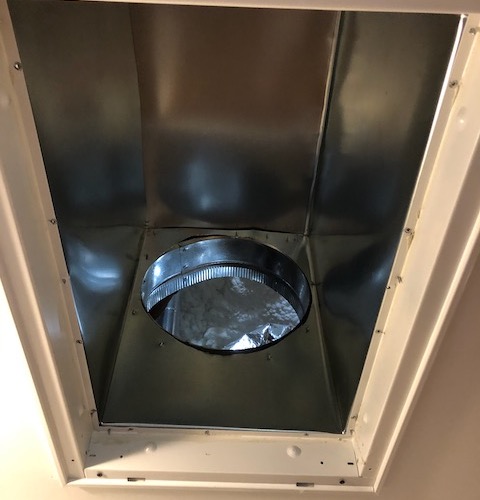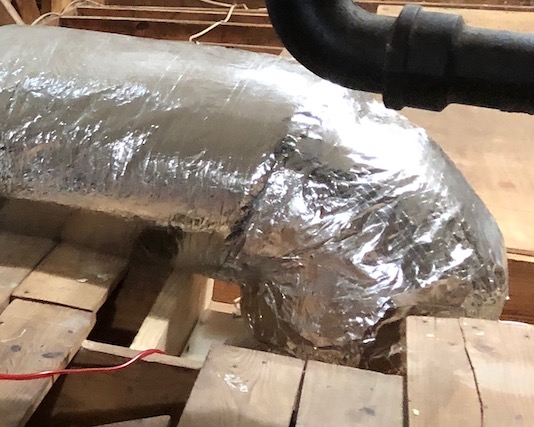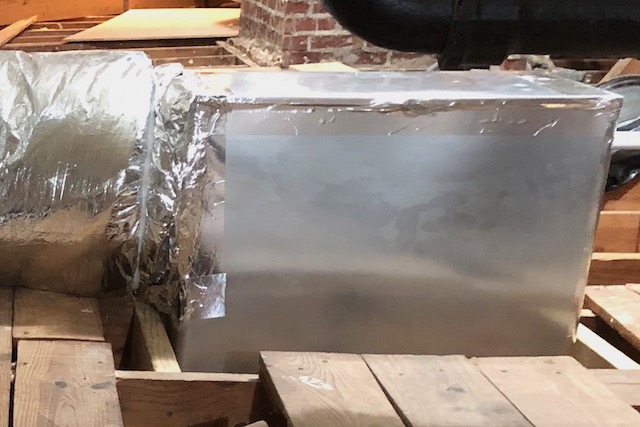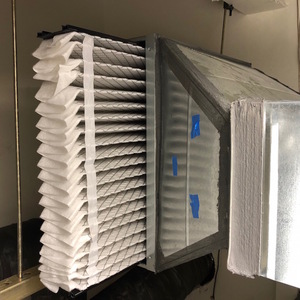
I hate it when I don’t see ahead of time what seems obvious afterward. I’ve assembled a lot of things in my life, including a house and I can’t tell you how many times I get to the end, and then have to undo everything because I put a piece in backward or skipped a step. Like that time I got halfway through installing the second-floor back wall of the house I built before I noticed the window openings were in the wrong place because I started with the structural insulated panels (SIPs) upside down. Today’s story is something like that, but not quite so frustrating.
Pressure drop across high-MERV filters
I’ve written quite a few articles about filters in the past two years, including how to get a low pressure drop across high-MERV filters. Most recently, I wrote about how I applied those principles to the three filters in the new ducted minisplit air handlers at my house. And before that, I wrote about why I like MERV-13 and higher for good indoor-air quality because filters with that rating are supposed to capture a minimum of 85% of the particles that are about 2.5 microns in size.
So, to be able to use high-MERV filters, you need to keep the pressure drop low. If the filter is too restrictive, the pressure drop across it is too high. High pressure drop can either reduce your air flow or increase your energy use, depending on what type of blower your air handler has. (For the curious and the geeks: fixed-speed blowers with permanent-split capacitor motors will have reduced air flow, and variable-speed blowers with electronically commutated motors will use more energy to maintain air flow.)
To keep the pressure drop low, the first thing you need to do is have a lot of filter area. And by area, I’m mainly talking about length times width, the face area. Deeper filters have more fabric area, but that doesn’t always correlate with proportionally lower pressure drop. (See my article about studies on air high-MERV filters and air flow. Study #2 looked at this issue.) The rule we use in our HVAC design work at Energy Vanguard is to size the filter at 2 sq. ft. of face area for each 400 cubic ft. per minute (cfm) of air flow through the filter. That results in a face velocity of 200 ft. per minute.
For the filters in my house, I actually ended up with about 3.7 sq. ft. of face area per 400 cfm and a face velocity of about 100 ft. per minute. When I wrote about my pressure drop measurements back in June, I told you that I measured 0.08 in. of water column (i.w.c.) to 0.09 i.w.c. I wanted it to be lower, but those numbers were pretty darn good for MERV-13 filters.
Don’t squeeze the air
In case you aren’t aware of this yet, John Semmelhack of Think Little in Virginia is one of the most knowledgeable people in the world on the topic of air flow. I discussed my pressure drops with him to find out why they were higher than I expected, and he pointed out something that, in hindsight, should have been obvious to me from the beginning.

The photo above shows the filter grille return box in June, when I made the original measurements. The filter grille itself is about 2.5 in. deep and holds a 2-in.-deep filter. The topside of the box is covered with sheet metal with a duct near the middle. What this means is that air being pulled into the return had an easier time going through the middle part, where it could go straight into the duct. Air definitely got pulled in through the whole filter, though, because they all looked uniformly dirty when I replaced them. But that lack of space above a large part of the filter restricted air flow and increased pressure drop.
So I embiggened the return box above the filter. (What are you talking about?! “Embiggen” is a perfectly cromulent word.) Semmelhack recommends a minimum of 6 in. of space above the filter, so I more than tripled that. The photo below shows the size of the new return box, with about 21 in. of space above the filter.

I would have gone with 6 in. or so, but by embiggening it this much, I was able to eliminate the elbow in the return duct above the filter box and bring the duct straight into the side. Here’s the view from the attic before the retrofit:

And here’s what it looks like now:

Of course, you’re wanting to know if there was any change in my pressure drop, and yes, there was. Why would I be writing about it otherwise? The pressure drop across the three filters (all the same size, 16x25x2, and all MERV-13) was less than 0.06 i.w.c. for all of them. The actual measurements were 0.0532, 0.0573, and 0.0593 i.w.c. Those numbers correspond to improvements of 34%, 28%, and 30%, respectively, compared to my June measurements. And that’s with three months of accumulation on the filters.
Let me add one caution here, though. I made my return boxes so large because they’re in a conditioned attic. If you’re doing this in an unconditioned attic, it’s best to keep the surface area of the ducts smaller. With very high temperature differences between the air inside the duct—even return air—and the attic air, extra duct area can add significantly to your duct loads.
I also measured the effect of the grille by measuring it both open and closed. It turns out the pressure drop across the grille when you have such a low face velocity is also really low. The highest one was 0.006 i.w.c.
So, the lesson here is: Don’t squeeze the air. Look at your duct design and see if there’s anyplace where the air flow will be constricted. If you see places like that, send any apprentices on the job with you back to the truck for the embiggener. It should be right next to the wire stretcher.
_________________________________________________________________________
-Allison Bailes of Atlanta, Georgia, is a speaker, writer, building science consultant, and founder of Energy Vanguard. He is also the author of the Energy Vanguard Blog. You can follow him on Twitter at @EnergyVanguard. Photos courtesy of the author.
Weekly Newsletter
Get building science and energy efficiency advice, plus special offers, in your inbox.















18 Comments
Thanks, Allison. I've always wondered if having a "boot" like this amounts to one more elbow in the whole system. I guess with air speed that low maybe it just doesn't matter?
Order of magnitude? Your before- pressure drop is 0.9 and after 0.06 ..?
Li Ling, I haven't measured the total external static pressure with the new return box yet, but I'm sure it's lower, too.
Sorry about the mistake. I put the decimal in the wrong place for my original pressure drops. That should have been 0.08 to 0.09 i.w.c. I've corrected it now.
Great Article. I just read this on LinkedIn as well, and will need to look at the system in my house. I have a similar condition to Allison's before picture (with about 3" of space to the round duct) and if I can improve how my HVAC system works or it's efficiency with that simple of a change I am all for it. Keep the great articles and information coming!
So how much effect in terms of $/year in reduced fan operating cost to achieve the same air flow? That's the figure I need for most optimization projects. I'll take a guesstimate - $10/year?
Thank you for the insights. While fan operating cost may be of interest, the Mitsubishi SEZ ducted air handlers are low static, which can give rise to various issues.
I addressed stratification/throw in a 22' x 30' great room serviced by a SEZ-KD15, with two supplies and two returns. Last month, I had the filter box replaced with the Mitsubishi FBL1-2, which has 1x12x34 (comes with a 1x12x14 and a 1x12x20 that I am replacing with a Web Lifetime custom 1x12x34). The filter sits at an angle in the FBL1-2, so filter area and cross-sectional flow area differ, which can be taken into account when computing theoretical FPM. As to performance, it replaced a filter box with two 2x5.625x11.75 (not at an angle). The SEZ-KD15 has CFM of 353/441/529 for lo/med/hi.
On "hi" (529 CFM), measurements at one of the supplies increased from 360 FPM to 409 FPM (per anemometer on tripod). Without any filter (old box), it was 490 FPM. In essence, the old "hi" is the new "med" and I now have a new "hi" (tests with filters had new, clean filters of common MERV rating).
The SEZ-KD units/heat pumps are purported to operate more efficiently with higher air flow at the heat exchanger. Further, greater throw means more effective heat transfer in a room and less direct "looping" back to returns. Additionally, mini-split systems are known to be "slow" (lag) in response to a change in temperature setting. More throw, greater efficiency . . . help to increase responsiveness (like when someone complains and wants it colder/warmer right now).
My install for the SEZ-KD15 was particular, as the KD12 and KD9 got filter boxes similar to Dr. Bailes. Fortunately, those filter boxes have plenty of area and are deep. Not as nice as Dr. Bailes new filter box, but seemingly better than his old one.
When dealing with ducted mini-split/heat pump systems, with low static, as you can see, what seems like a "small" improvement can be substantial. These systems require "systems" thinking. In Western MT winters, minor tweaks on a heat pump system add up to comfort and savings (savings of over 100 kWh per month). And, if tied in with PV, additional savings may be possible too (systems thinking).
Covid-19 presents additional challenges for low static and other systems too (see recent article on WA State choir superspreader event https://scholar.colorado.edu/concern/articles/n583xw008). People like Dr. Bailes hold particular knowledge that can help us get back to normal. Something as small as sizing a filter box can be quite important. Would Dr. Bailes be interested in providing a review of that article ;-)
Hi,
What is a web lifetime custom filter?
My Mistubishi ducted mini splits were installed with an additional 4" filter at the air handler in the same size as the 1' filter that comes with the unit. After several horrendous electric bills using a MERV 13 filter (throwback to conventional system), I switched to 4" thick Merv 8 and saw a huge drop in electric bill. I also stopped rolling back the nighttime temp by more than a degree and set the fan speed to high. Happy with results. I think the installer should have fabricated a larger box for the additional filter - but he didn't. I was not aware of the FBL 1-2.. Is there a reason other than the obvious improved iaq that you switched to it? And, why don't the Mitsubishi units come with better filters built in? Thanks.
A
Unfortunately web lifetime stopped making custom sized filters (MERV 8 washable), they do sell a filter that is adjustable in size, but you may need two of them and have to cut beyond the pre-set adjustable sizes.
My Mitsubishi units came with the thin window screen type of filter (eighth inch thick or less), which is to protect the blower from particles (good idea). I'm not sure who thought "protective filters" should become "IAQ" filters. To me, it's best to separate. If you want IAQ, get an air purifier.
The size of the inlet to the SEZ 15 unit is less than 8" x 36" and any filter(s) are going to be well below 2 sq ft in area. With the FBL 1-2, you get about 2.8 sq ft in area (at an angle). I use a 1" MERV 8 web lifetime (approx. 12" x 34"). I can't imagine using a 4" thick filter that is less than 2 sq ft in area. The resistance is too high for the low static (0.2 in water) SEZ unit. Your story/data provide proof that filters matter for low static air handlers.
My other two SEZ units (12 and 9) have fabricated boxes that fit large filters - not angled (16" x 24").
Again, for IAQ, I have other units, with IAQ (particulate) sensors. Those units switch on automatically and switch off automatically - for their intended purpose. HVAC has one intended purpose - to move heated (or cooled) air - they switch off/on or otherwise regulate based on temperature and not IAQ. So, why put IAQ duty on the HVAC? Because someone can sell it to you for increased profit along with a supply of throw away filters - that increase energy usage and decrease performance of the HVAC system.
Very old school. This is what my father .. a mechanical engineer .. recommended back in 1986 when he did the HVAC design for my house. I was the person in the rafters installing the vents in the ceiling for the AC. The only thing we ever changed was downsizing the air handler after insulating the attic.
What is your source for 2" filters and filter grilles?
I've been buying custom size filters from https://www.airfiltersdelivered.com
Great article! I am noticing your painter's tape around the filter. Are we supposed to be taping off the edges each filter change? Also, ideally, how much smaller should the exact filter measurement be compared to the inside dimensions of the housing? My current filters are virtually the same size as the opening, and they're nearly impossible to get in without deforming the box. I plan to order custom-sized filters going forward... what tolerance should I use?
Allison: Thanks for this article! I had to "de-biggen" (reduce height of) the 30" x 24" return box in my ceiling which transitions to a 20" flexible insulated round duct. I did this to allow the 20" duct to better clear roof joists in the crawl space above and make a less-constrained 90' bend (seemed like a good idea at the time). In any event, I now have 7" of height between finished ceiling and top of return box where 20" round transition happens (see image). I'd like to increase filter depth from 1" to 2" or even 4", but the latter would violate the 6" clear rule behind the filter. Any thoughts on how to think about this tradeoff? I'm not really in a position to measure pressure drop precisely (or at all). Thanks!
Following. Interested in the answer to this.
I have 9.5", of which 1" is currently taken up by my filter, leaving 8.5". So even if I switched to a 2" filter, I'd have 7.5" behind it. If 6" is the min, seems my system may be a good candidate for 2" filters.
Can anyone point me to a return air grille that accepts a deeper filter? I just don't understand why you can't find a 4in deep one. I hate these 1in filters.
I have used this one that takes 2” deep filters. https://www.homedepot.com/p/Venti-Air-20-in-x-20-in-Takes-2-in-Thick-Filter-Square-Return-Air-Filter-Grille-of-Steel-in-White-H2FG2020/313461880
Here’s a manufacturer you can contact. https://www.dayus.com/darh-fg4-return-blade-filter-grille-aluminum-4
I just ordered up and tested one of these inline boxes, which do require more space, but do so in a way which is excellent for flow. I'm measuring approx .05" drop@60 CFM. This is using a 14x14x4" filter rated at MERV 13. Ignore the masking tape...it's just being used to mock up the system for packaging in its final install location :-)
The way that the air enters and leaves the box is about ideal for air flow. They also have a HEPA version which is more expensive, but looks to do a better job with respect to sealing around the filter in the box.
CFB-6 from https://www.hvacquick.com/products/residential/Filter-Boxes/Inline-Filter-Boxes/HVACQuick-CFB-Series-MERV-13-Inline-Filter-Boxes
That is good, I thought of it. Problem is it would require going through the scuttle into the attic to change the filter. Deal breaker for 60 year olds and up.
I just can't believe this is such a unique request. I am going to have to draw it up and have it fabricated. I don't have a brake.
Log in or create an account to post a comment.
Sign up Log in